Effect of Polishing Systems on the Surface Roughness and Color Stability of Aged and Stained Bulk-Fill Resin Composites
Abstract
1. Introduction
2. Materials and Methods
2.1. Preparation of Samples
2.2. Polishing of Resin Composites
2.3. Surface Roughness
2.4. Staining Protocol
2.5. Color Stability
2.6. SEM Evaluation
2.7. Statistical Analysis
3. Results
3.1. Surface Roughness
3.2. Color Stability
3.3. SEM Images of Surface Topography
4. Discussion
5. Conclusions
- (1)
- The polishing method, aging, and staining with coffee significantly affect the surface roughness and color stability of resin composites.
- (2)
- The tested specimens polished with the multi-stage Super-Snap discs produce a smoother surface on all bulk-fill resin composites than the specimens polished with the two-stage Diacomp plus Twist (p ≤ 0.05).
- (3)
- Polishing helps to change the surface quality of stained restorations, yet it might not be adequate to entirely eliminate stains and restore the coloration to a clinically acceptable level.
- (4)
- The diamond-incorporated two-step twist polishing system, with a Mohs hardness of 10, may be preferred for re-polishing coffee-stained methacrylate-based resin composites to return them to a clinically acceptable level.
- (5)
- Further research is needed with various polishing materials, along with more in vivo and additional in vitro studies, to address the issue of surface irregularities causing color changes in the oral environment. Additionally, the impact of factors like mechanical stresses, pH variations, and enzymatic activity in the oral environment should be thoroughly investigated.
Author Contributions
Funding
Institutional Review Board Statement
Informed Consent Statement
Data Availability Statement
Conflicts of Interest
References
- Fontes, S.T.; Fernández, M.R.; Moura, C.M.; Meireles, S.S. Color stability of a nanofill composite: Effect of different Immersion Media. J. Appl. Oral Sci. 2009, 17, 388–391. [Google Scholar] [CrossRef]
- Paolone, G.; Moratti, E.; Goracci, C.; Gherlone, E.; Vichi, A. Effect of finishing systems on surface roughness and gloss of full-body bulk-fill resin composites. Materials 2020, 13, 5657. [Google Scholar] [CrossRef]
- Freitas, F.; Pinheiro de Melo, T.; Delgado, A.H.; Monteiro, P.; Rua, J.; Proença, L.; Caldeira, J.; Mano Azul, A.; Mendes, J.J. Varying the polishing protocol influences the color stability and surface roughness of bulk-fill resin-based composites. J. Funct. Biomater. 2020, 12, 1. [Google Scholar] [CrossRef]
- Jang, J.H.; Park, S.H.; Hwang, I.N. Polymerization Shrinkage and Depth of Cure of Bulk-Fill Resin Composites and Highly Filled Flowable Resin. Oper. Dent. 2015, 40, 172–180. [Google Scholar] [CrossRef]
- Türkün, L.Ş.; Türkün, M. Effect of bleaching and repolishing procedures on coffee and tea stain removal from three anterior composite veneering materials. J. Esthet. Restor. Dent. 2004, 16, 290–301. [Google Scholar] [CrossRef]
- Ipek, İ.; Bilge, K. The effect of different liquids on the surface roughness and color stability of single shade and nanohybrid resin composites: An AFM and SEM analysis. Microsc. Res. Tech. 2024, 1–9. [Google Scholar] [CrossRef]
- Available online: https://www.kulzer.com/int2/en/products/charisma-bulk-flow-one.html (accessed on 19 January 2024).
- Available online: https://www.tokuyama-us.com/estelite-bulk-fill-flow-dental-composite/ (accessed on 12 February 2024).
- Barutcigil, Ç.; Yıldız, M. Intrinsic and extrinsic discoloration of dimethacrylate and Silorane based composites. J. Dent. 2012, 40, e57–e63. [Google Scholar] [CrossRef]
- Bilgili, D.; Dündar, A.; Barutçugil, Ç.; Tayfun, D.; Özyurt, Ö.K. Surface properties and bacterial adhesion of bulk-fill composite resins. J. Dent. 2020, 95, 103317. [Google Scholar] [CrossRef]
- Karadaş, M.; Demirbuğa, S. Evaluation of color stability and surface roughness of bulk-fill resin composites and nanocomposites. Meandros Med. Dent. J. 2017, 18, 199–205. [Google Scholar] [CrossRef]
- Sabatini, C.; Campillo, M.; Aref, J. Color stability of ten resin-based restorative materials. J. Esthet. Restor. Dent. 2011, 24, 185–199. [Google Scholar] [CrossRef]
- Luo, M.R.; Cui, G.; Rigg, B. The development of the CIE 2000 colour-difference formula: CIEDE2000. Color Res. Appl. 2001, 26, 340–350. [Google Scholar] [CrossRef]
- Paolone, G.; Formiga, S.; De Palma, F.; Abbruzzese, L.; Chirico, L.; Scolavino, S.; Goracci, C.; Cantatore, G.; Vichi, A. Color stability of resin-based composites: Staining procedures with liquids—A narrative review. J. Esthet. Restor. Dent. 2022, 34, 865–887. [Google Scholar] [CrossRef] [PubMed]
- Schulze, K.A.; Marshall, S.J.; Gansky, S.A.; Marshall, G.W. Color stability and hardness in dental composites after accelerated aging. Dent. Mater. 2003, 19, 612–619. [Google Scholar] [CrossRef] [PubMed]
- Ertas, E.; Güler, A.U.; Yücel, A.Ç.; Köprülü, H.; Güler, E. Color stability of resin composites after immersion in different drinks. Dent. Mater. J. 2006, 25, 371–376. [Google Scholar] [CrossRef] [PubMed]
- Dantas, D.C.B.; Mathias, I.F.; Borges, A.B.; Torres, C.R.G.; Caneppele, T.M.F. Effects of artificial accelerated aging on the optical properties of resin composites. Biosci. J. 2018, 34, 505–513. [Google Scholar] [CrossRef]
- Augusto, M.G.; de Andrade, G.S.; Mathias-Santamaria, I.F.; Dal Piva, A.M.d.O.; Tribst, J.P.M. Comparison of Polishing Systems on the Surface Roughness of Resin Based Composites Containing Different Monomers. J. Compos. Sci. 2022, 6, 146. [Google Scholar] [CrossRef]
- Aytac, F.; Karaarslan, E.S.; Agaccioglu, M.; Tastan, E.; Buldur, M.; Kuyucu, E. Effects of novel finishing and polishing systems on surface roughness and morphology of nanocomposites. J. Esthet. Restor. Dent. 2016, 28, 247–261. [Google Scholar] [CrossRef] [PubMed]
- Elmarsafy, S.; Abdelwahab, S.; Hussein, F. Influence of polishing systems on surface roughness of four resin composites subjected to thermocycling aging. Dent. Res. J. 2023, 20, 35. [Google Scholar] [CrossRef]
- Szczepaniak, M.E.; Krasowski, M.; Bołtacz-Rzepkowska, E. The Effect of Various Polishing Systems on the Surface Roughness of Two Resin Composites—An In Vitro Study. Coatings 2022, 12, 916. [Google Scholar] [CrossRef]
- Wheeler, J.; Deb, S.; Millar, B.J. Evaluation of the effects of polishing systems on surface roughness and morphology of dental composite resin. Br. Dent. J. 2020, 228, 527–532. [Google Scholar] [CrossRef]
- Atasayar, E.; Ulusoy, N. The effect of blocker application on color matching of different colored composite resin systems. Materials 2023, 16, 4954. [Google Scholar] [CrossRef] [PubMed]
- Perez, M.; del Ghinea, R.; Herrera, L.J.; Ionescu, A.M.; Pomares, H.; Pulgar, R.; Paravina, R.D. Dental Ceramics: A CIEDE2000 acceptability thresholds for lightness, chroma and hue differences. J. Dent. 2011, 39, e37–e44. [Google Scholar] [CrossRef] [PubMed]
- Paravina, R.D.; Ghinea, R.; Herrera, L.J.; Bona, A.D.; Igiel, C.; Linninger, M.; Sakai, M.; Takahashi, H.; Tashkandi, E.; del Mar Perez, M. Color difference thresholds in Dentistry. J. Esthet. Restor. Dent. 2015, 27, S1–S9. [Google Scholar] [CrossRef] [PubMed]
- Antonson, S.A.; Yazici, A.R.; Kilinc, E.; Antonson, D.E.; Hardigan, P.C. Comparison of different finishing/polishing systems on surface roughness and gloss of resin composites. J. Dent. 2011, 39, e9–e17. [Google Scholar] [CrossRef] [PubMed]
- Can Say, E.; Yurdagüven, H.; Yaman, B.C.; Özer, F. Surface roughness and morphology of resin composites polished with two-step polishing systems. Dent. Mater. J. 2014, 33, 332–342. [Google Scholar] [CrossRef] [PubMed]
- Choi, M.-S.; Lee, Y.-K.; Lim, B.-S.; Rhee, S.-H.; Yang, H.-C. Changes in surface characteristics of dental resin composites after polishing. J. Mater. Sci. Mater. Med. 2005, 16, 347–353. [Google Scholar] [CrossRef] [PubMed]
- Morresi, A.L.; D’Amario, M.; Capogreco, M.; Gatto, R.; Marzo, G.; D’Arcangelo, C.; Monaco, A. Thermal cycling for restorative materials: Does a standardized protocol exist in laboratory testing? A literature review. J. Mech. Behav. Biomed. Mater. 2014, 29, 295–308. [Google Scholar] [CrossRef]
- Hasanain, F.A. Effect of Ageing, Staining and Polishing on the Colour Stability of a Single, a Group Shade and Nano Fill Dental Composite: An In-vitro Study. J. Clin. Diagn. Res. 2022, 16, ZC26–ZC27. [Google Scholar] [CrossRef]
- Chowdhury, D.; Mukherjee, S.; Maity, I.; Mazumdar, P. Surface roughness and microhardness evaluation of composite resin restorations subjected to three different polishing systems immediately and after 24 h: An in vitro study. J. Conserv. Dent. Endod. 2023, 26, 639–645. [Google Scholar] [CrossRef]
- Erdemir, U.; Sancakli, H.S.; Yildiz, E. The effect of one-step and multi-step polishing systems on the surface roughness and microhardness of novel resin composites. Eur. J. Dent. 2012, 06, 198–205. [Google Scholar] [CrossRef]
- Venturini, D.; Cenci, M.S.; Demarco, F.F.; Camacho, G.B.; Powers, J.M. Effect of polishing techniques and time on surface roughness, hardness and Microleakage of resin composite restorations. Oper. Dent. 2006, 31, 11–17. [Google Scholar] [CrossRef] [PubMed]
- Alqarni, D.; Alghamdi, A.; Saad, A.; Alzahrani, A.A.; Hosaka, K. Effect of surface polishing on nano-hardness and elastic modulus of different resin composites after immersion in alcoholic medium. J. Compos. Sci. 2021, 5, 327. [Google Scholar] [CrossRef]
- Pratten, D.H.; Johnson, G.H. An evaluation of finishing instruments for an anterior and a posterior composite. J. Prosthet. Dent. 1988, 60, 154–158. [Google Scholar] [CrossRef] [PubMed]
- Sarac, D.; Sarac, Y.S.; Kulunk, S.; Ural, C.; Kulunk, T. The effect of polishing techniques on the surface roughness and color change of composite resins. J. Prosthet. Dent. 2006, 96, 33–40. [Google Scholar] [CrossRef]
- Ishii, R.; Takamizawa, T.; Tsujimoto, A.; Suzuki, S.; Imai, A.; Barkmeier, W.; Latta, M.; Miyazaki, M. Effects of finishing and polishing methods on the surface roughness and surface free energy of bulk-fill resin composites. Oper. Dent. 2020, 45, E91–E104. [Google Scholar] [CrossRef]
- Filiz, H.; Avunduk, A.T.E.; Yanardağ, E.C. Diş hekimliğinde yüzey pürüzlülüğü araştırma yöntemleri: Derleme makalesi. Uşak Üniversitesi Diş Hekim. Fakültesi Derg. 2023, 2, 28–35. [Google Scholar]
- Mukhija, B.; Kandaswamy, D.; Venkatesh, V. Surface Roughness of a nanocomposite after finishing with different polishing systems—A two dimensional profilometric evaluation. Int. J. Clin. Dent. 2012, 5, 319–326. [Google Scholar]
- Tepe, H.; Erdılek, A.D.; Sahın, M.; Efes, B.G.; Yaman, B.C. Effect of different polishing systems and speeds on the surface roughness of resin composites. J. Conserv. Dent. 2023, 26, 36–41. [Google Scholar] [CrossRef]
- Pérez, M.; Del Saleh, A.; Yebra, A.; Pulgar, R. Study of the variation between CIELAB ΔE* and CIEDE2000 and CIEDE2000 color-differences of resin composites. Dent. Mater. J. 2007, 26, 21–28. [Google Scholar] [CrossRef]
- Bagheri, R.; Tyas, M.J.; Burrow, M.F. Subsurface degradation of resin-based composites. Dent. Mater. 2007, 23, 944–951. [Google Scholar] [CrossRef]
- İskender, N.; Ersöz, B.; Aydın, N.; Karaoğlanoğlu, S.; Oktay, E.A. Investigation of water absorption and color change of indirect composite resins. Eur. Ann. Dent. Sci. 2021, 48, 46–51. [Google Scholar] [CrossRef]
- Anfe, T.E.; Agra, C.M.; Vieira, G.F. Evaluation of the possibility of removing staining by repolishing composite resins submitted to artificial aging. J. Esthet. Restor. Dent. 2011, 23, 260–267. [Google Scholar] [CrossRef] [PubMed]
- Mundim, F.M.; da Garcia, L.; de Pires-de-Souza, F. Effect of staining solutions and repolishing on color stability of direct composites. J. Appl. Oral Sci. 2010, 18, 249–254. [Google Scholar] [CrossRef] [PubMed]
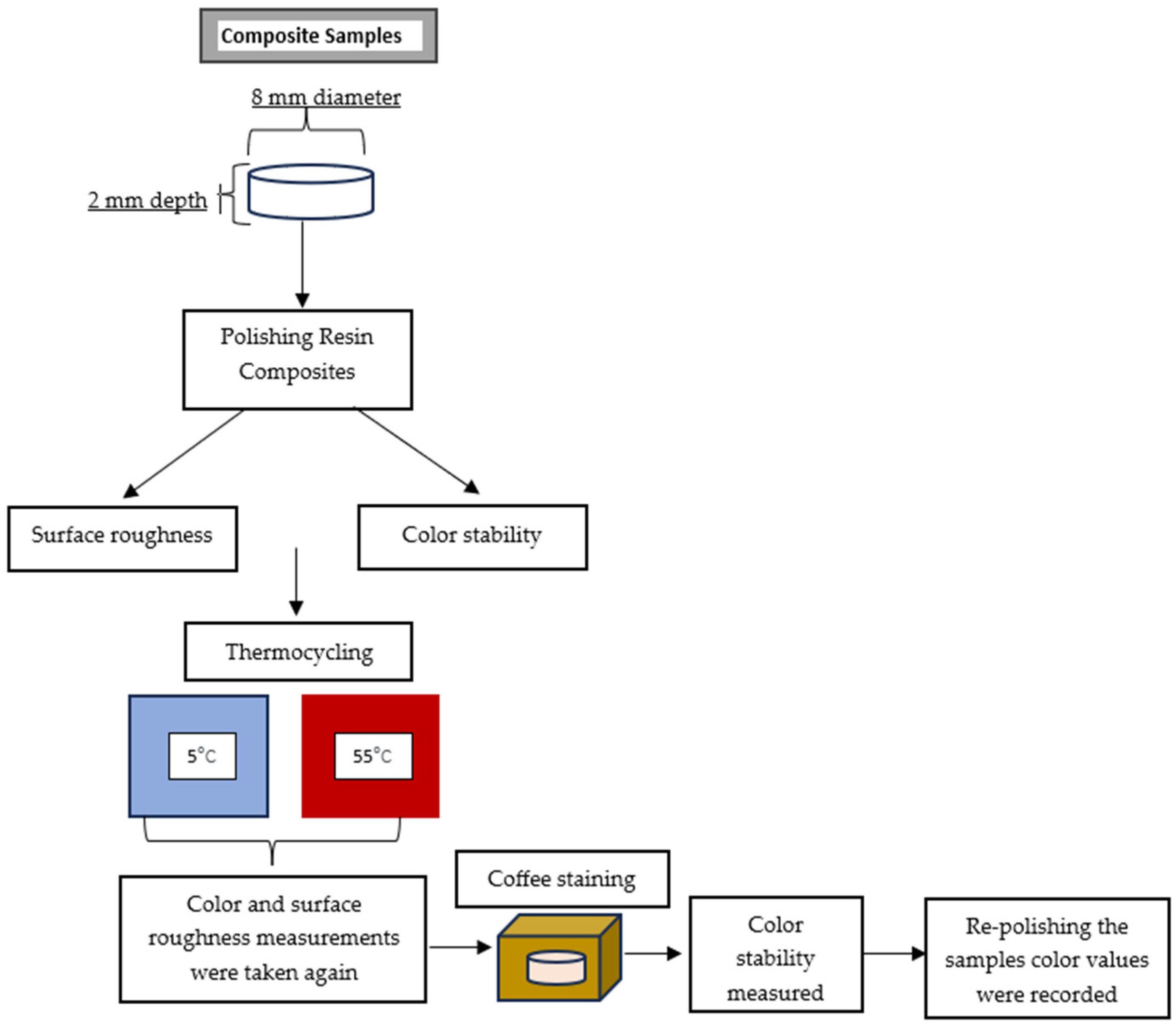
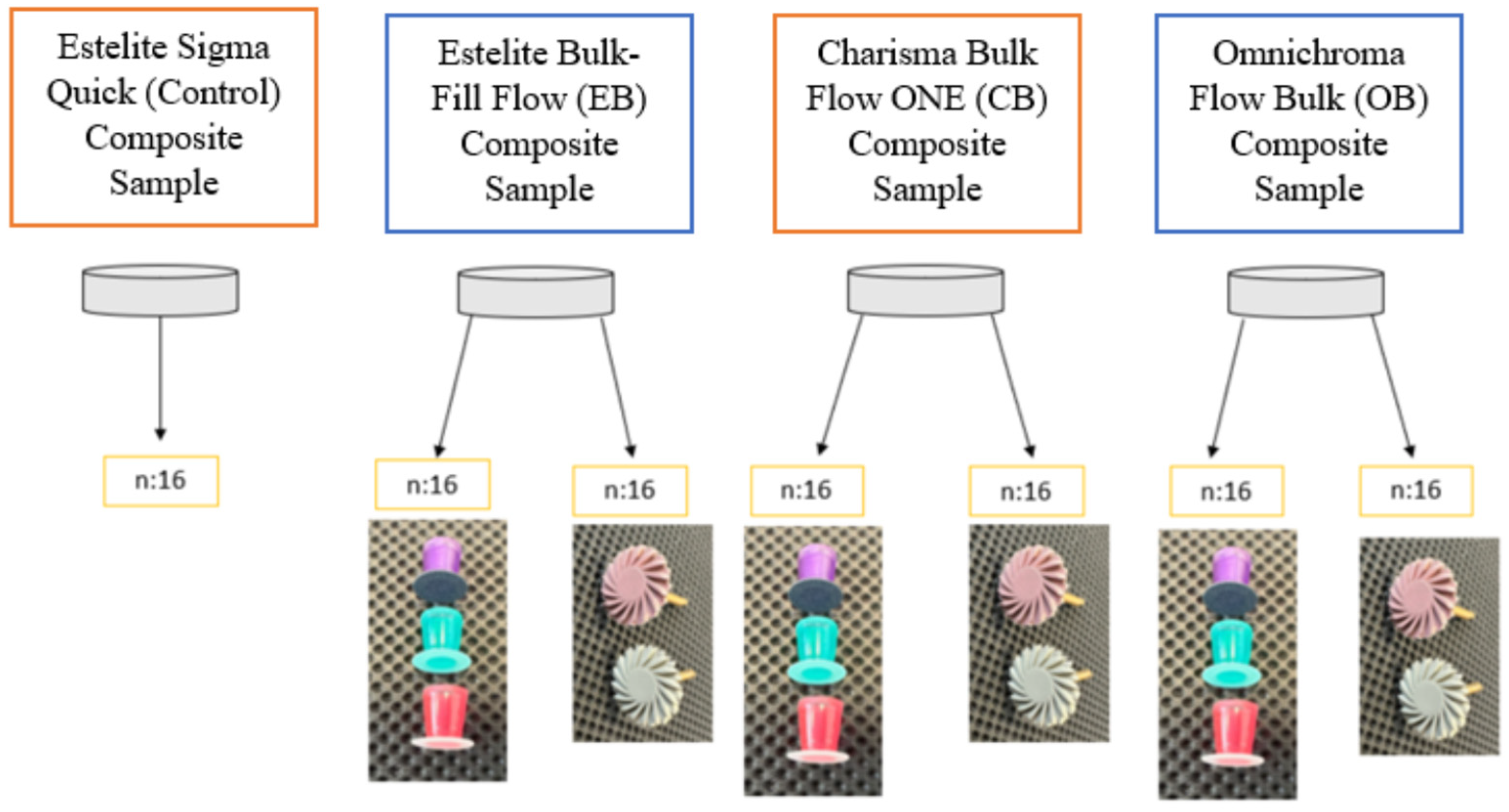
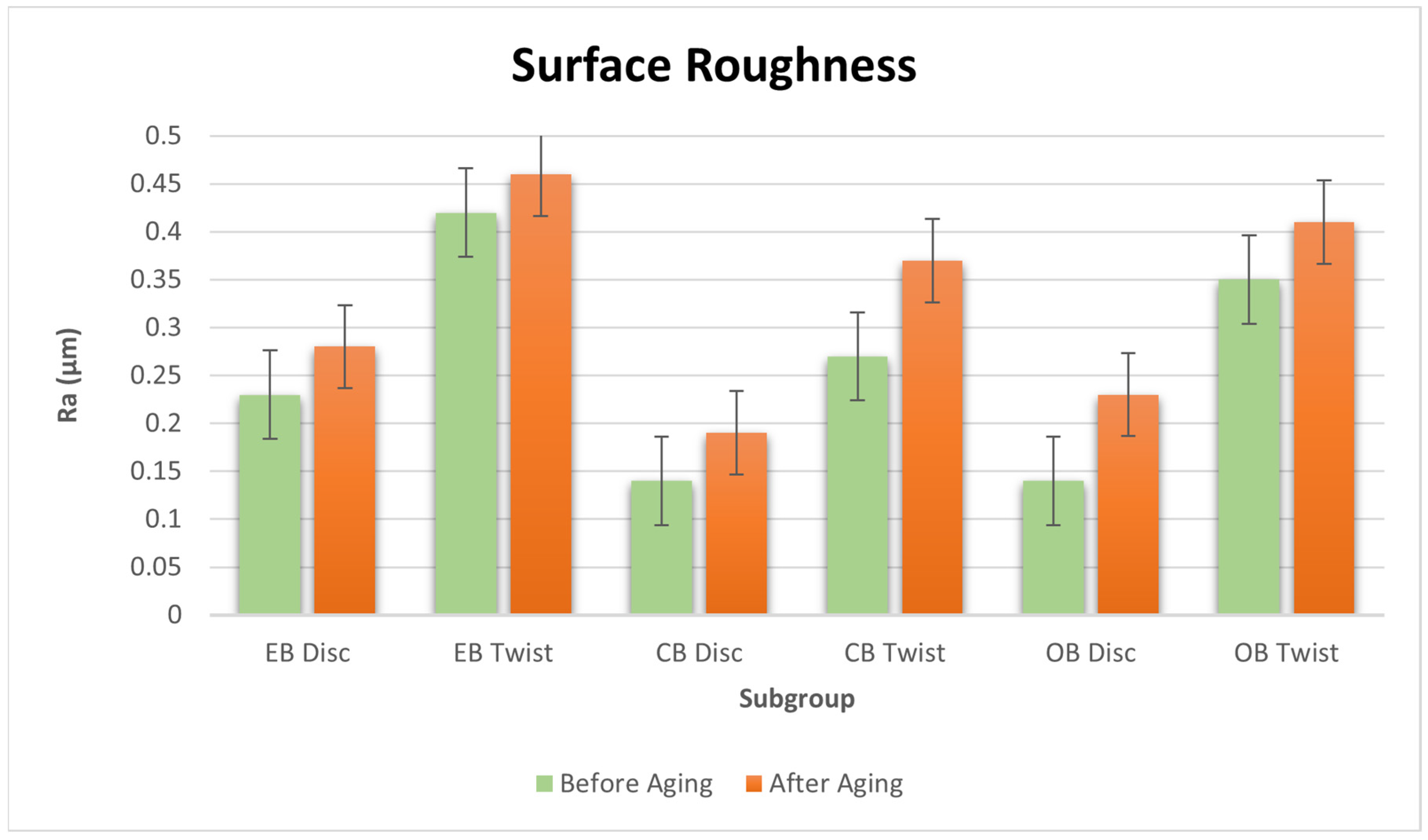
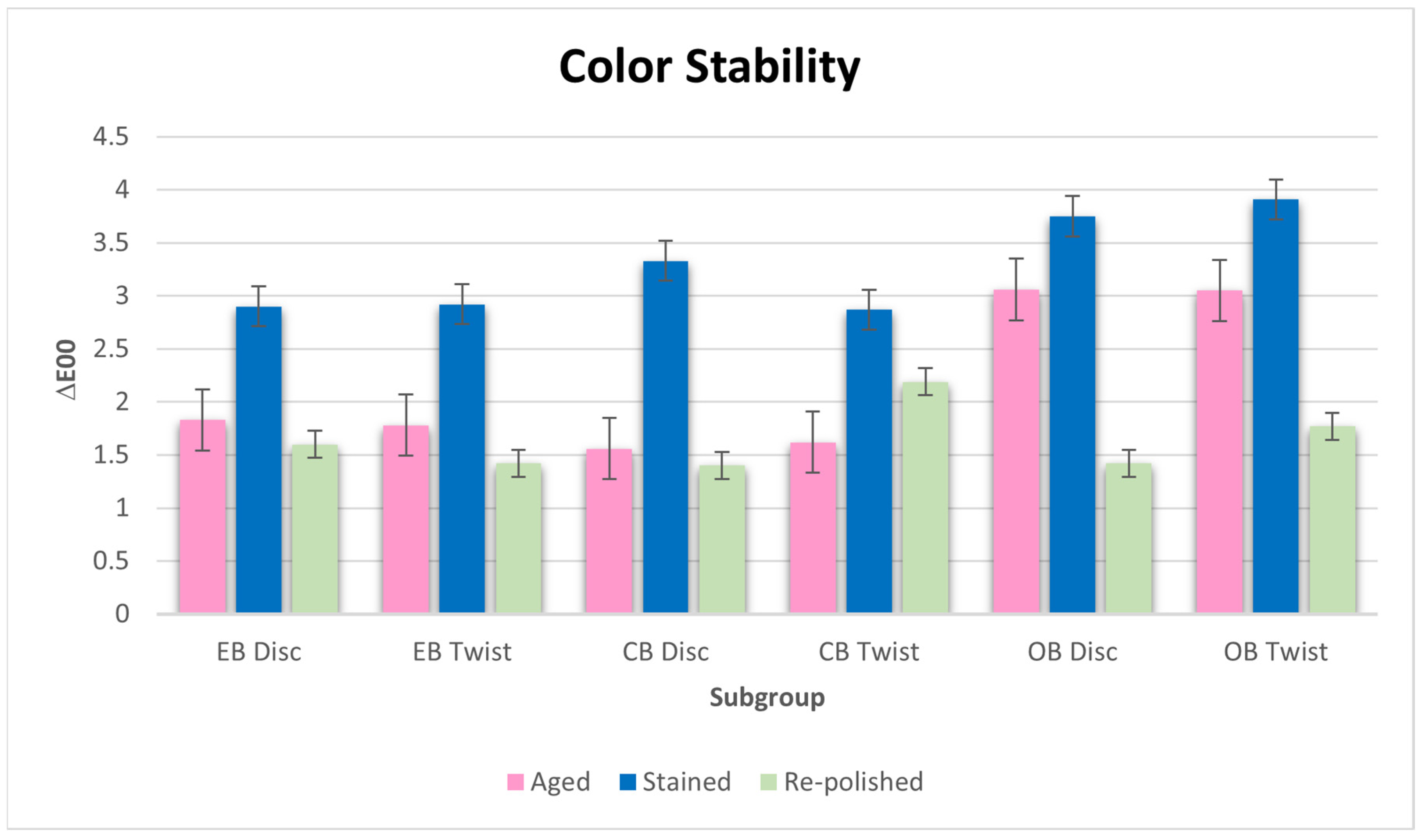
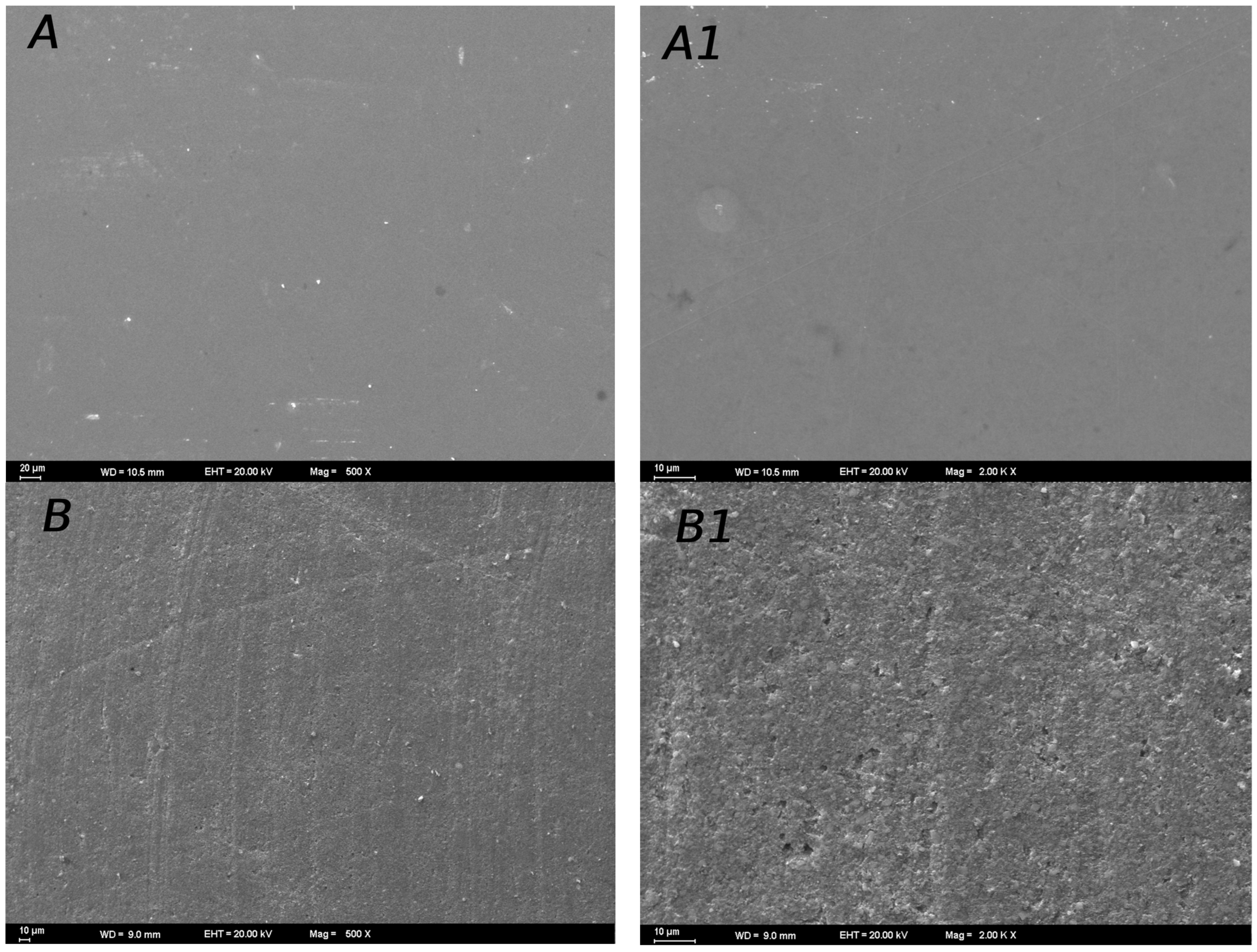
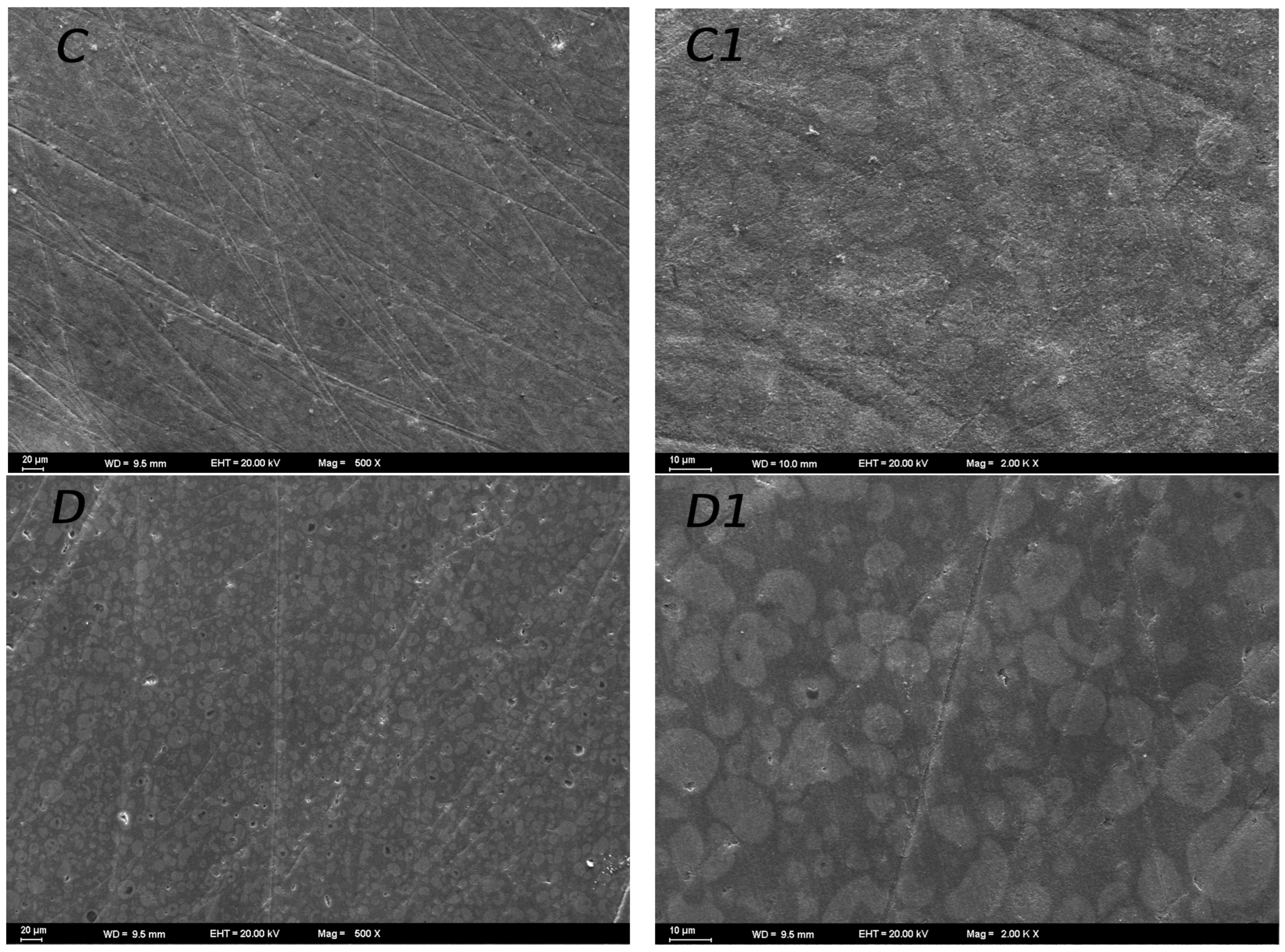
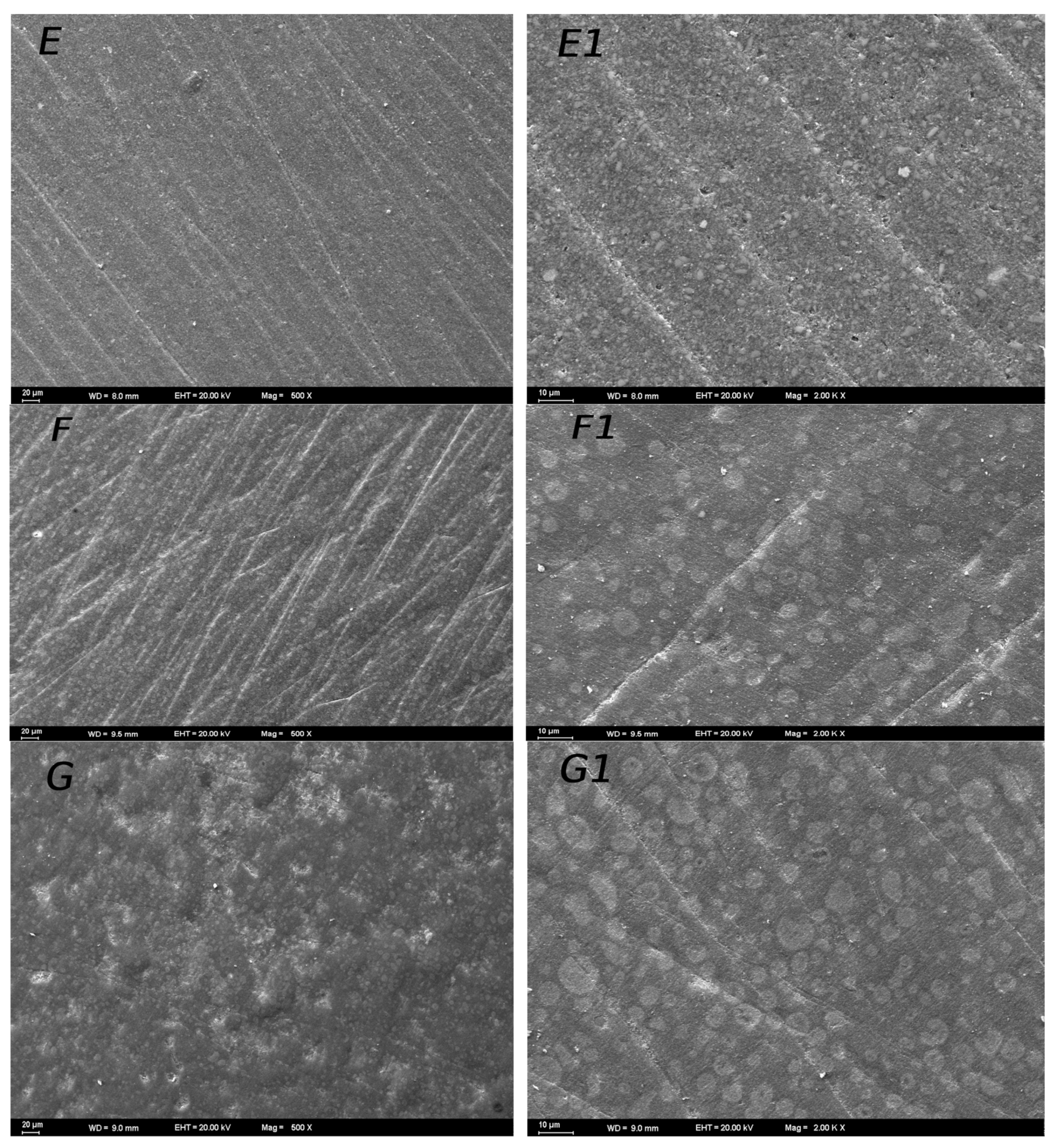
| Material | Manufacturer | Filler Type | Monomer | Shades | Seri No | Fıller Load | Particle Size |
|---|---|---|---|---|---|---|---|
| Estelite Sigma Quick (Control) | Tokuyama (Japan) | Silica-zirconia fillers, silica-titania fillers | BisGMA, TEGDMA | A1 | E3232 | 82% wt (71% vol) | 0.2 μm |
| Estelite Bulk Fill Flow (EB) | Tokuyama (Japan) | Supranano-spherical filler | BisGMA, TEGDMA Bis-MPEPP | A1 | 41912 | 70% wt (56% vol) | 0.2 μm |
| Charisma Bulk Flow One (CB) | Kulzer (Germany) | Ba-AI-F silicate glass, YbF3 and SiO2 | UDMA, EBADMA | Universal | NO10026 | 65% wt, (41%vol) | 0.02–5 μm |
| Omnichroma Flow Bulk (OB) | Tokuyama (Japan) | Supranano- spherical filler | UDMA/1,9-Nonanediol Dimethacrylate | Universal | 011E03 | 69%wt (55 vol%) | 0.2–0.4 μm |
| Material | Polishing System | Before Aging | After Aging | p-Value |
|---|---|---|---|---|
| EB | Disc | 0.23 ± 0.05 b | 0.28 ± 0.04 b | <0.001 * |
| Twist | 0.42 ± 0.05 A | 0.46 ± 0.05 A | ||
| CB | Disc | 0.14 ± 0.05 a | 0.19 ± 0.05 a | <0.001 * |
| Twist | 0.27 ± 0.08 B | 0.37 ± 0.06 A | ||
| OB | Disc | 0.14 ± 0.05 a | 0.23 ± 0.05 b | <0.001 * |
| Twist | 0.35 ± 0.05 A | 0.41 ± 0.08 A |
| Material | Polishing System | Aged (SD) | p-Value | Stained (SD) | p-Value | Re-Polished (SD) | p-Value |
|---|---|---|---|---|---|---|---|
| EB | Disc | 1.83 ± 0.42 a | 0.515 | 2.90 ± 0.45 a | 0.906 | 1.60 ± 1.27 a | 0.293 |
| Twist | 1.78 ± 0.39 A | 2.92 ± 0.66 A | 1.42 ± 0.72 A | ||||
| CB | Disc | 1.56 ± 0.32 a | 0.654 | 3.33 ± 0.8 a | 0.128 | 1.40 ± 0.58 a | 0.013 * |
| Twist | 1.62 ± 0.45 A | 2.87 ± 0.87 A | 2.19 ± 1.02 A | ||||
| OB | Disc | 3.06 ± 0.54 b | 0.930 | 3.75 ± 0.70 b | 0.445 | 1.42 ± 0.76 a | 0.293 |
| Twist | 3.05 ± 0.41 B | 3.91 ± 0.57 B | 1.77 ± 1.05 A |
Disclaimer/Publisher’s Note: The statements, opinions and data contained in all publications are solely those of the individual author(s) and contributor(s) and not of MDPI and/or the editor(s). MDPI and/or the editor(s) disclaim responsibility for any injury to people or property resulting from any ideas, methods, instructions or products referred to in the content. |
© 2024 by the authors. Licensee MDPI, Basel, Switzerland. This article is an open access article distributed under the terms and conditions of the Creative Commons Attribution (CC BY) license (https://creativecommons.org/licenses/by/4.0/).
Share and Cite
Aktu, A.; Ulusoy, N. Effect of Polishing Systems on the Surface Roughness and Color Stability of Aged and Stained Bulk-Fill Resin Composites. Materials 2024, 17, 3576. https://doi.org/10.3390/ma17143576
Aktu A, Ulusoy N. Effect of Polishing Systems on the Surface Roughness and Color Stability of Aged and Stained Bulk-Fill Resin Composites. Materials. 2024; 17(14):3576. https://doi.org/10.3390/ma17143576
Chicago/Turabian StyleAktu, Ayşem, and Nuran Ulusoy. 2024. "Effect of Polishing Systems on the Surface Roughness and Color Stability of Aged and Stained Bulk-Fill Resin Composites" Materials 17, no. 14: 3576. https://doi.org/10.3390/ma17143576
APA StyleAktu, A., & Ulusoy, N. (2024). Effect of Polishing Systems on the Surface Roughness and Color Stability of Aged and Stained Bulk-Fill Resin Composites. Materials, 17(14), 3576. https://doi.org/10.3390/ma17143576






